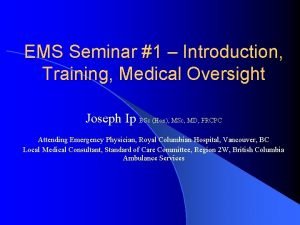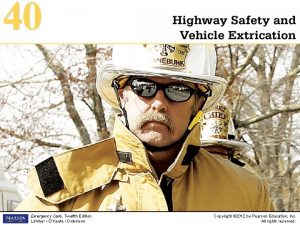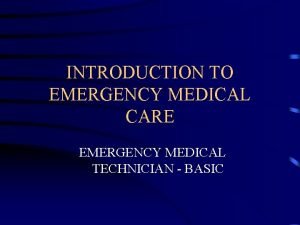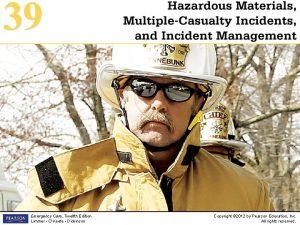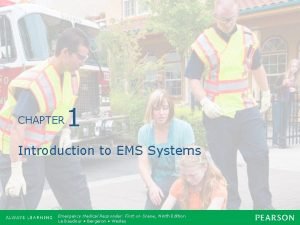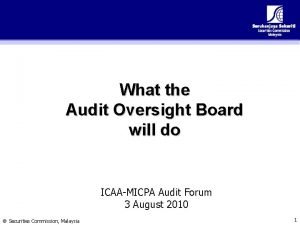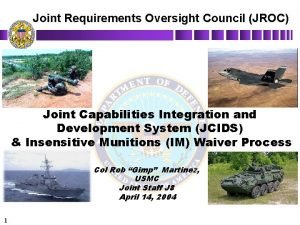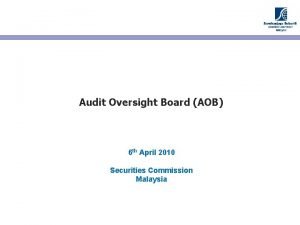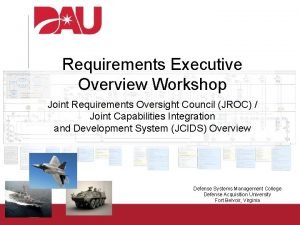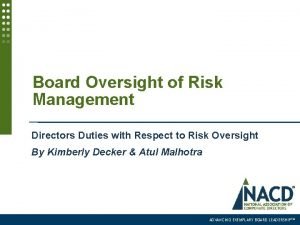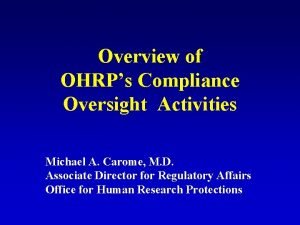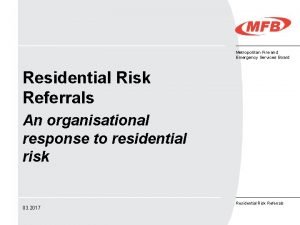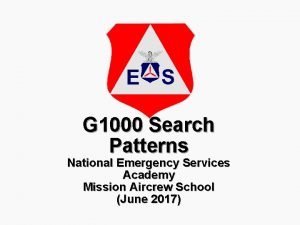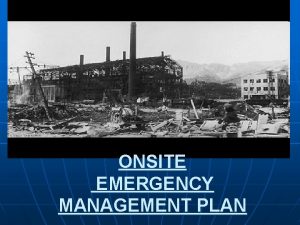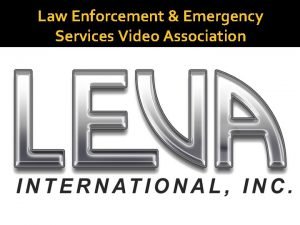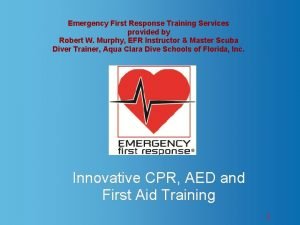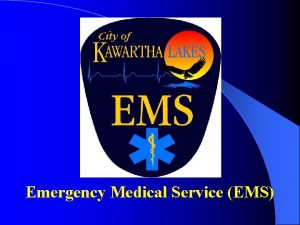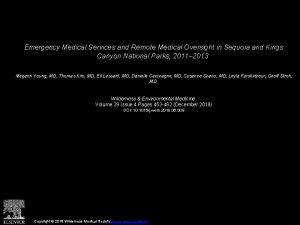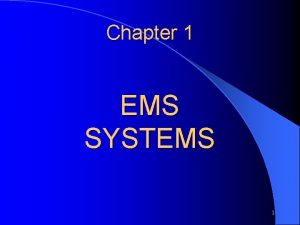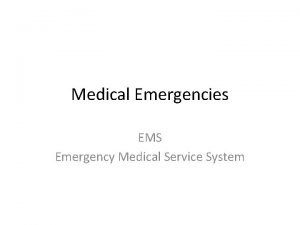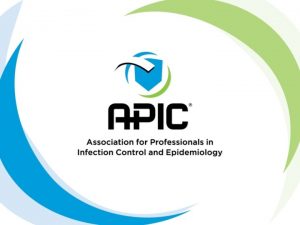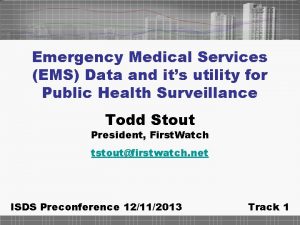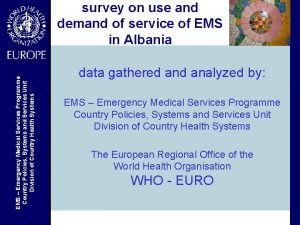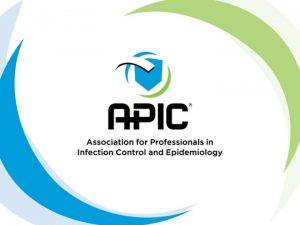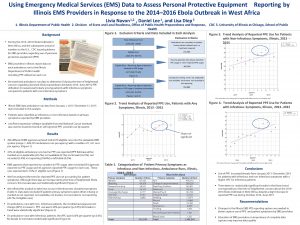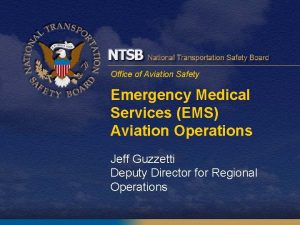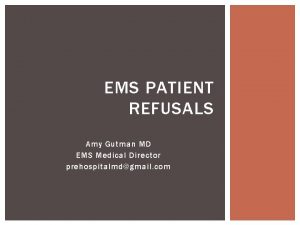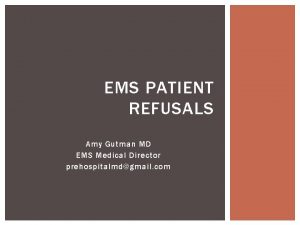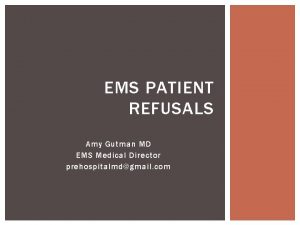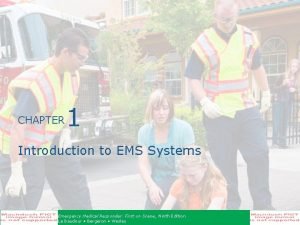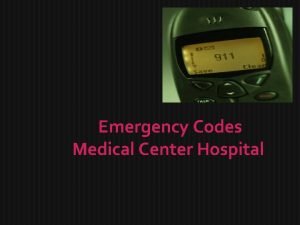Emergency Medical Services EMS Overview Medical Oversight Introduction































- Slides: 31

Emergency Medical Services EMS Overview & Medical Oversight

Introduction • • • History of EMS System Levels of training and abilities Overview of system designs Local system design Medical control

History of EMS 1917 Honolulu Police Department Ambulance

History of EMS • Before 1966 • 1966 - 1973 • 1974 - 1981 • 1981 - Present

Before 1966 • Jean Dominique Larrey – Napoleon’s Chief Military Physician – wounded treated on battlefield and horse drawn carriages constructed to carry the wounded • Civil War – First organized pre-hospital system in U. S. – Joseph Barnes, Johnathan Letterman - Military physicians – Union Army trained corpsmen - first “medics”

Before 1966 • Civil War – Developed a transportation system • Post Civil War – Cincinnati, New York, London, Paris • Horse Accidents, fires - need for transport – Edward Dalton • Former Surgeon in Union Army • 1869 began New York City Ambulance • Interns staffed ambulances

Before 1966 • World War I – Improved communications - signal boxes – Electric, steam, gasoline powered carriages – Thomas traction splint – Ambulances now equipped • Post World War I – Radios to dispatch ambulances – Volunteer rescue squad – Interns still on ambulance

World War II • U. S. Entrance into WWII – Removed interns from ambulance – Deterioration of care - untrained – Little care, mostly transportation – Half of ambulances operated by mortuaries • Post WWII – CPR, defibrillation – 1966 Belfast Ireland Mobile CCU

1966: A Turning Point • National Academy of Sciences - National Research Council – Described pre-hospital care and compared it to military pre-hospital in Korean Conflict – Described lack of communication, lack of helicopter services, archaic ED’s – Led to the National Highway Safety Act

National Highway Safety Act • Department of Transportation as Federal Governing authority by finances • Funded Training programs and national minimum standards of skills • Communications programs and equipment • Funded Ambulances, equipment, • Personnel and administrative cost • 1968 - 1979, $142 Million

Other Federal Initiatives • Health Services and Mental Health Administration – Lead Agency for EMS within Department of Health, Education and Welfare (DHEW) • Physician Responder Programs – metamorphosed into “paramedic” programs – close physician supervision • mostly on-line medical control • Telemetry programs begun

Public Law 93 -154, 1973 • Goal to improve EMS on National Scale • 15 Elements flawed - idea of chain of survival • State control of EMS efforts • BLS and ALS Terminology spread • Communications – 1 in 20 ambulances voice communication – advocated 911 access and central dispatch

EMS System • • • Access First Responder EMT / Paramedic Medical Control Transport to definitive care

911 System • Centralized access number • >90% of country covered • Enhanced System provides name, address, telephone number • Abuse of system

Providers - Scope of Practice • First Responders – CPR – First Aid – Basic Airway Management – Emergency Delivery – Spinal Immobilization – Oxygen Administration – Assisted Ventilation

Scope of Practice EMT - A • Scope of First Responders • On Scene Triage • Fracture Splinting • Extrication and Transport • MAST

Scope of Practice EMT-I • • Scope of EMT-A EOA, Combi-tube Orotracheal Intubation Peripheral IV cannulation • Basic determination of death (obvious) • Defibrillation (AED)

Scope of Practice - Paramedic • Needle cricothyroidotomy • Needle Decompression of pneumothorax • Defibrillation, Cardioversion • Administration of most drugs, antiarrhythmics, benzodiazepines, and narcotics

Georgia EMS • No registered First Responder • EMT (Basic EMT) - national EMT-I – D 50, Epi-pen • Cardiac Technicians - Closely approximates National Paramedic • Paramedic - Expanding Curriculum

System Structure • Municipality – City or County run organization – Fire Department based • Hospital Based – Hospital owned and operated – County 911 provider • Private and volunteer • Combination and Tiered Response

Response Systems • • BLS EMS ALS EMS BLS EMS with ALS Back-up Tiered Response – Fire BLS or ALS Response – ALS Transport Service – Police, Fire and ALS

Medical Control • Direct (On-line) Medical Control – Direct physician to medic contact • Radio • Telephone • Off-Line Medical Control – Writing and approving protocols – Quality Assurance

Protocols • • • Written standards Do not require physician contact Require a physician signature Governed by local EMS council Sparingly used in Region 6 EMS Liberally used in most of U. S.

Direct Medical Control • Telephone and Radio contact most common • Radio – “Key-up” 1 -2 seconds before speaking – Speak clearly and slowly – Its not a telephone - most radio systems are Simplex not duplex – Break-up common making understanding difficult

Medical Control Scenarios - 1 • “Medical Control this is Rural Metro 416 Basic EMT Johnson. I am on the scene with a ***STATIC*** year old male who is complaining of shortness of breath, he has a history of asthma and has used his albuterol inhaler with some relief but is still short of breath. The patient is refusing treatment and transport… What do you advise ?

Medical Control Scenario - 1 • Vital Signs BP 116/76, HR 110, R - 20, No wheezing noted, noted to be using some accessory muscles • Alert and Oriented answering questions appropriately

Medical Control Scenario - 2 • Medical Control this is Horizon Medic 6. I am enroute to you with 67 year old female patient who was complaining of substernal chest pain, and is now is cardiac arrest. She is intubated. Has been defibrillated X 3 and remains in V-fib. I have an IV initiated of normal saline. What do you advise?

Medical Control Scenarios - 3 • Medical Control this Rural Metro 702 at incident command. I am on the scene of a chemical release and have a multiple casualty incident. We approximate 45 patients have been exposed to an unknown gas believed to be sulfur trioxide. I have 6 category I patients, 10 category II, and the remainder are category III. I need destination orders. All 45 patients are “requesting your facility”

Medical Control Scenario - 4 • Med Control this is Smith County EMA Medic 2. Paramedic Davis. I am enroute with a driver of high speed MVC with massive damage to the vehicle. The patient is c/o CP and leg pain, Vitals are stable. The patient is requesting transport to St. Joseph’s hospital and refuses transport to the trauma center… What do you advise?

Medical Control Scenario - 5 • Medical Control this is Horizon Medic 6. I am on the scene with a 14 y/o female. Bystanders witnessed a GTC seizure and called EMS. The patient is now alert, oriented and following commands but refuses treatment and transport. We have attempted to contact the parents without success. What do you advise ?

Medical Control Scenarios - 6 • Medical Control this is Rural Metro 413. I am on the scene with a 48 y/o female. EMS was called by a friend whom the patient told in a phone conversation that she wanted to commit suicide. On our arrival the patient admits to the statement, but states that she is not “really suicidal” Bottles of medications including TCA’s are in the home. What do you advise?
 Provincial medical oversight
Provincial medical oversight Introduction to emergency medical care
Introduction to emergency medical care Tdh ems
Tdh ems Medical
Medical Introduction to emergency medical care
Introduction to emergency medical care Introduction to ems systems chapter 1
Introduction to ems systems chapter 1 Audit oversight board malaysia
Audit oversight board malaysia Jcids process
Jcids process Aob sanction
Aob sanction Brig. gen
Brig. gen Board of directors risk oversight responsibilities
Board of directors risk oversight responsibilities Management oversight and risk tree
Management oversight and risk tree Public procurement oversight advisory board
Public procurement oversight advisory board Ohrps
Ohrps Delivery oversight
Delivery oversight Oversight
Oversight Administrative oversight definition
Administrative oversight definition Risk based oversight
Risk based oversight Regulatory oversight definition
Regulatory oversight definition Low income oversight board
Low income oversight board Congress is most likely to exert oversight
Congress is most likely to exert oversight Master data services overview
Master data services overview Sql server master data services
Sql server master data services Metropolitan fire and emergency services board
Metropolitan fire and emergency services board National emergency services academy
National emergency services academy Onsite emergency plan
Onsite emergency plan Law enforcement and emergency services video association
Law enforcement and emergency services video association The importance of training
The importance of training Emt chapter 14 medical overview
Emt chapter 14 medical overview Multicullar
Multicullar Papercut job tickerting print management
Papercut job tickerting print management Introduction product overview
Introduction product overview
